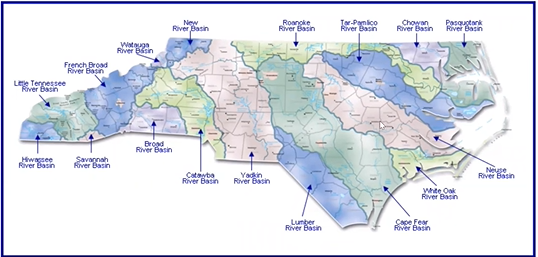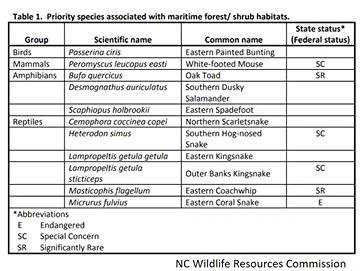SE Coastal Plain and Piedmont
SE Coastal Plain and Piedmont
Southeastern Evergreen Forest
Longleaf, Loblolly, and Slash Pine
Maritime forest
Cypress-gum
Pocosin and Atlantic whitecedar
Bottomland hardwood
Hydrology, microtopography, soils, and disturbance are major factors that separate forest types from the Coastal Plain.
Live oak (Quercus virginiana)
Maritime Forest
Forest structure
Species composition
Canopy
Live oak, loblolly pine, sand laurel oak
Shrubs
Yaupon holly, eastern redcedar, waxmyrtle
Understory/herb layer—sparse
Wildlife value
Environmental factors
Disturbance
Temperature/precipitation not selective factors
Sandy soils
Wind and storms
Salt spray and overwash (forms thick canopy layer to protect from salt spray)
Disturbance regime
Threats
Development
Climate change, especially sea level rise (ghost forests)
Which direction are we looking (north or south)?

North (ocean is East)
What are the key environmental factors that shape maritime forests?
Cypress-Gum Forests
Forest structure
often adjacent to bottomland sites
wettest of the coastal plain forest types; often flooded 3-6 months
Canopy of flood-tolerant species
Understory limited
No herbaceous layer
Species composition
Brownwater swamps (more widespread)
Baldcypress and Nyssa biflora (smaller leaves than blackgum)
Blackwater swamps
Blackcypress and Nyssa aquatica
Other species: Carolina ash, red maple, black gum
Environmental factors
Flooded in winter and early spring; flooded 3-6 months of the year
Flooding is the major selective factor that determines what species can survive
Disturbance regime
No cycle of regular natural disturbance; no fire
Hurricanes are periodic
Can be very long-lived
Threats
Climate change and saltwater intrusion
Carolina Bays, Pocosins, and Atlantic whitecedar
IMPORTANT: While the origin of the word “pocosin” is Algonquin, it does NOT translate to “swamp on a hill.” It is a generic term that refers to a wet area
Carolina bays describe some SE coastal plain geography; pocosins and Atlantic whitecedar are 2 community types found in Carolina Bays. Pocosins are closely related to Bay Forests.
Carolina Bays
Elliptical bays that either have open water or wetland forests
NW-SE orientation
Mostly organic soils and “bay” forests (either pocosin or Atlantic whitecedar)
Sandy rim (xeric longleaf pine forest) on the SE rims
Many have been drained and converted to agriculture
Ongoing debate about origin and formation
Carolina bays were thought to have formed through wind and weather patterns
Both types share seasonally wet, organic soils
The main difference (we think) is the disturbance regime
Pocosin and Bay Forests—moderate fire regime (about 10 year cycle)
Atlantic whitecedar—infrequent but catastrophic fire
Pocosin or Bay Forest
Environmental factors
Organic soils, from a few feet to 12 ft deep
Bays and depression ponds fill with partially decayed leaves, turns into “muck”
Organic soils hold water like a sponge
Forest structure
Canopy often open—also described as an evergreen shrub bog
Drier sites have trees and are called Bay Forests
Thick and evergreen midstory or understory of “bay” species
Often woven together with vines
Little herbaceous understory
Species composition
Canopy
Pond pine, Pinus serotina
Understory/shrub layer
Bay species: titi, sweetbay magnolia, swampbay, loblollybay
Vines weave everything together in a thick tangle
Disturbance - 10 year fire cycle
Pond pine: fire adapted: serotinous cones, epicormic branching, thick bark to withstand some fire
Threats
Former threats: ditching and draining for land conversion
Now: fire suppression, climate change
Atlantic Whitecedar Forests
Forest structure and disturbance regime
used to exist in pure, even-ages stands
remaining stands like this are rare; some found in the Albemarle/Pamlico penninsula in NC
even-aged structure suggest that catastrophic disturbance is needed for regeneration
Fire cycle through to be > 50 years
Large plant biomass = hot fires, clears seed bed
Selective cutting converted forests to gum and red maple
Species composition:
Atlantic whitecedar
Fire as a selective mechanism in the SE Coastal Plain
Frequent, low-intensity
longleaf pine
plants are adapted to survive fire
seed germination during non-fire season (fall)
grass stage
long, lush protective needles
loss of dead branches
thick bark
Infrequent, high-intensity
Atlantic whitecedar
plants can regenerate after fire
serotinous cones
abundant cone production; precocious (produce cones early)
short needles
dead branches retained (ladder)
thin bark
Longleaf pine, pondpine, and whitecedar are all shade intolerant with different adaptations
Bottomland Hardwood Forests

Forest structure
Geography: adjacent to brown or blackwater rivers, with periodic flooding
Closed canopy
Understory variable but uneven-aged, can be shrubby
Herb layer may or may not be rich
Species composition
Brownwater rivers
higher diversity; nutrient-rich sediment
Oaks dominant
Also green ash, sweetgum, American elm, musclewood
Blackwater rivers
Quercus laurifolia and Pinus taeda dominant
Understory: Magnolia virginiana, Persea palustris, Cyrilla racemiflora
Environmental factors
Brownwater rivers (also called redwater rivers)—originate in the Piedmont or Mountains, contain sediment
Blackwater rivers: originate in the Coastal Plain, lack sediment, but high in tannins—acidic, dark, and clear
Which type has a greater diversity of species? → Brownwater (blackwater is acidic and lacks sediment)
Wet and low-lying
Fires are not a factor (too wet to burn)
important habitat for birds like prothonotary warbler
Notice, also, that the species in brownwater Bottomland Hardwoods are common species of the Piedmont, and (not surprisingly), blackwater Bottomland Hardwoods have species that are more restricted to the Coastal Plain.
Disturbance regime
logged extensively for valuable timber
hurricanes
Threats
Habitat loss
conversion to agriculture
timber harvest
development
Invasive species
emerald ash borer
